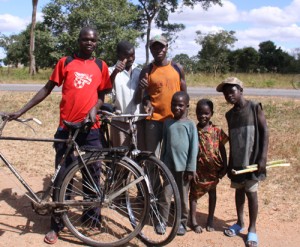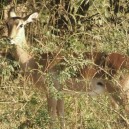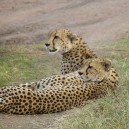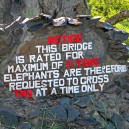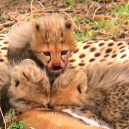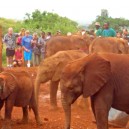Full-length Self Drive Safari Itinerary
Click here for Kenya Rhino and Ranches tour details
Sunday – Day 1: David Sheldrick Wildlife Trust Elephant Orphanage and Lake Naivasha
Our journey begins in Nairobi, the buzzing Capital of Kenya. We take some time to be acquainted with our vehicles and the rest of our small group before visiting the David Sheldrick Wildlife Trust Elephant Orphanage. Baby elephants are rescued from all over Kenya and beyond, flown to Nairobi where they are cared for and raised as elephants by human keepers. They are taught life skills much like their mum would have in the wild. Eventually they are released to an orphaned herd on Tsavo NP before making their own mark on life! We are privileged to visit this refuge and watch as baby ellies slurp humongous bottles of baby formula and play in the mud. These little dears are guaranteed to melt your heart. It is possible to adopt a baby elephant or rhino – the perfect gift for animal lovers back home.

Within Nairobi National Park is the David Sheldrick Elephant orphanage. They also take in orphaned Rhino, this little one was very excited to see the crowd
After lunch we hit the highway and drive to the shores of Lake Naivasha. The drive through the great Rift Valley is stunning as we glide along the top before gently descending to the base.
We arrive at our hotel in the late afternoon, check in, and have some free time to take a dip in the pool, wander to lake’s edge to watch hippos wallowing in the shallows or simply grab a cold Tusker beer and relax in the garden while colobus and vervet monkeys watch from overhead in the trees.
Driving Distance: 100km
Meals: breakfast, lunch, dinner
Accommodation: Hotel
Monday – Day 2: Green Crater Lake and Elsamere
Nothing beats a gentle early walking safari in the cool crisp morning air. Accompanied with our local guide we stroll through Green Crater Lake as giraffe, eland, zebra, warthogs and various antelope graze on the sweet dewy grass. Green Crater lake boasts a high concentration of indigenous trees and plants that have been used for centuries by the local population for every ailment under the sun. Our local guide expertly explains what different plants are used for from cleansing the liver to natural lipstick!
We return to our hotel for some free time to relax, maybe take an afternoon nap, grab a good book or do a spot of shopping to work up an appetite for our afternoon visit to Elsamere – the home of “Born Free”.
In the afternoon we get back behind the steering wheel for the short drive to Elsamere. Elsamere was Joy and George Adamson’s lakeside retreat when they were not in the bush researching, photographing or saving lions! Today it is a tourist attraction showcasing original cameras, research and surveillance equipment once used by George in the field. The original dining room is used to serve an scrumptious high tea of everything from creamy meringues to crunchy oat cookies to death by chocolate cake. As we sit in the garden indulging in various cakes and puddings colobus monkeys wait in the shadows for us to walk away so they can help themselves to leftover treats.
Driving Distance: 40kms
Meals: breakfast, lunch, dinner
Accommodation: Hotel
WHAT OUR CUSTOMERS SAY…
A huge thank-you for the trip, for all your pre-plannine info Debs, for guiding us safely during the trip, Thiemo and looking after us so well and both of you for your generous hospitality and company. We were talking last night as to what we thought were the highlights and came to the conclusion that it was all so enjoyable and varied, from the animals on the Masai Mara to the highland dancing …. and putting the world to rights over a glass[es] of wine! We loved the tented camp and tree house …..
Tuesday – Day 3: Masai Mara Wildlife Reserve
We depart Lake Naivasha for the incredible award winning Masai Mara Wildlife Reserve. Made famous for the Wildebeest migration and many BBC African wildlife documentaries it truly lives up to its reputation.
The first part of the day we drive on good tar roads, a mix of open road and weaving our way through small bustling villages to busy open market places. By lunch time the tar road ends and for the last 50kms we are driving on rough dirt tracks. As we slowly make our to the Masai Mara gates we pass traditional Masai homesteads, kids herding cows and goats and women carrying large bundles of wood while ostrich, zebra, giraffe and eland keep a watchful eye.
We enter the Masai Mara in the afternoon and enjoy a game drive through this incredible ecosystem. We cannot help but smile as we think we are in the most talked about, photographed and proclaimed wildlife park in the World. To make it even more special we are driving an iconic Land Rover Defender, the vehicle most associated with Africa.
We arrive at our permanent tented camp on the shores of Talek River for 2 nights of glamping!
Driving Distance: 200kms
Meals: breakfast, lunch, dinner
Accommodation: Tented Camp
Wednesday – Day 4: Masai Mara Game Reserve
The Masai Mara teems with wildlife all year and the reason why it is voted year after year as the best game park in all of Africa. Imagine spending the day leisurely pottering along narrow dirt tracks in search of African wildlife. Imagine coming around the corner and spotting a pride of lions chilling by the side of the road while their young cheeky cubs playfully pull on dad’s golden mane or a herd of elephant gracefully, without a care in the world, gliding across the open savannah plains.
Driving around the Masai Mara we will spot an incredible concentration of various wildlife and if we are lucky we will see the more unusual or elusive animals like leopard and wild dog. But one thing is for sure the beauty and diversity of wildlife grazing together will leave us in awe.
The Masai Mara is most famous for large prides of lion, cheetah roaming the open plains, herds of zebra, giraffe and large family units of elephant with the young using Mum for shade so their sensitive trunks do not get sunburn, buffalo, topi and eland, and groups of hyena scouting for their next meal. The number of species is long and endless.
During the months of June to September you may want to head to the popular Mara River in the hope of seeing wildebeest and zebra make the famous crossing for the incredible Migration while Nile crocodiles wait patiently for their once a year feast.
While game driving we stop to photograph wildlife including elephant, buffalo, giraffe, topi, warthogs, mongoose, ostrich, lion, leopard, jackals, hyena, cheetah and rhinoceros.
At night we fall asleep to the sounds of Africa.
Driving Distance: Variable
Meals: breakfast, lunch, dinner
Accommodation: Tented Camp
Thursday – Day 5: Njoro
We enjoy an early morning game drive as we make our way out of the Masai Mara toward our next 2 night stopover near Lake Nakuru NP.
Weather permitting we will take a spectacular back road over passes along the famous Mau forest to the village of Njoro and our home for the next 2 nights Kenana farm.
Kenana farm was established during the early years of colonisation by the Nightingale family. The story goes that back then the railway only went as far as Nakuru town from the port of Mombasa, so the family disembarked, hired porters and started walking with their worldly possessions. As the sun was about to set they set up camp for the night. When the family woke in the morning they realised all their porters had run off, scared by the night sounds of Africa. So unable to carry all their goods on their own they decided to farm where they were – and so they did!
A few generations later and Kenana farm still functions as a working farm as well as offering the opportunity to stay in several beautifully appointed quaint English style cottages. Kenana farm is also home to the childhood cottage of Beryl Markham, the first female pilot to fly solo from east to west across the Atlantic in 1936. The cottage was painstakingly relocated and restored in 2014.
After settling into our quaint English style cottages we are taken on a guided tour of the farm and to meet members of the successful community project Kenana Knitters. Kenana Knitters was an initiative established by the Nightingales to give the wives of the farm workers an income by knitting various items to sell to local tourists. The project soon propelled to fame and now goods are exported all over the world. The project not only enable the women to earn an income but also access health education and social interaction. The dye used for the wool is from natural plants grown on the farm. We dedicate ample time to wander through the on site shop to buy souvenirs for family and friends back home.
After dinner we can enjoy a glass of wine while sitting around the open fire telling stories of our experiences with African wildlife or you can sneak off for a hot bath in your cottage!
Driving Distance: 220kms
Meals: breakfast, lunch, dinner
Accommodation: Cottage
Friday – Day 6: Lake Nakuru National Park
Lake Nakuru National Park is a unique park situated right next to Nakuru town; houses end and the park starts – it’s really quite incredible! The electric fence keeps animals in and people out. The park boasts very fertile soil and the perfect environment for wildlife to breed freely, it is not uncommon for populations of wildlife to reach such enormous numbers that Kenya Wildlife Service relocate herds to parks in need of repopulating!
In addition to a healthy lion population and rather plump leopards Nakuru NP is home to a substantial number of critically endangered white and black rhino. White rhino like to move in groups and it is not uncommon to see 5-6 rhino hanging out together near Lake Nakuru, whereas black rhino are more elusive and solitary taking refuge in the thick bush. Nonetheless, Lake Nakuru NP will not disappoint with a plethora of wildlife as well as pelicans and flamingos taking advantage of the alkaline soda lake.
The park is also home to herds of waterbuck, zebra, rothschild giraffe, buffalo, hyena, gazelle, warthog, jackals, hippos and African wild dog to name a few.
The park is not huge however we have a full day to leisurely explore, taking our time to take in the various animals and beauty of Lake Nakuru.

It is very rare to see Hippo’s out of the water during the day. Low water in Lake Nakuru National Park meant this fella had to cross the road to reach his favourite spot in the lake.
Driving Distance: 80kms
Meals: breakfast, lunch, dinner
Accommodation: Cottage
Saturday – Day 7: The Great Rift Valley
We enjoy a sleep in before departing Njoro for Nakuru Town. Nakuru Town boasts a vibrant local souvenir market, it is worth taking some time to explore and barter for souvenirs. Bartering for goods in the markets is a Kenyan tradition and is often a lot of fun for you and the seller as jokes are made to lighten the event.
On our way back to Nairobi we stop for a local lunch. Nyama Choma literally translates to mean barbecue meat in Swahili. Nyama Choma is a popular weekend treat for Kenyans. Fresh beef, chicken, goat and lamb are barbecued over hot coals, cut into pieces before being piled onto wooden platters to share, served with traditional side plates of Kachumbari (tomato and dhania salad), Sukuma wiki (local collard greens) and Ugali (maize meal cooked with water). You will be pleasantly surprised at just how tasty this meal is!
With our stomach’s full and a taste for traditional Kenyan culture we continue to our guest house arriving in the late afternoon in time for a sun-downer, dinner and retire for the night ready for the adventure to continue tomorrow.
Driving Distance: 180kms
Meals: breakfast, lunch, dinner
Accommodation: Guest House
Day 8: Mt Kenya and Nanyuki
Leaving the Rift Valley we make our way to the foot of Kenya’s most famous mountain – Mt Kenya. An impressive mountain that may be a dwarf compared to Mt Kilimanjaro in size but not in technical skill. We wont be climbing it but will wake up to views of Mt Kenya in the morning!
We make our way through rich farming country to the service town of Nanyuki. Nanyuki, due to the climate was a favourite place for white settlers under the colonial years whom established vast ranches. Over the years many of these ranches have become private conservancies and wildlife sanctuaries playing an ever important role in protecting African wildlife. Ol Pejeta is just one example of a ranch turning to wildlife conservation. We are instantly taken in by the friendly locals and relaxed atmosphere. We spend the night about 10kms from Nanyuki in cottages with uninterrupted views of Mt Kenya.
This will be our base for 2 nights while we explore the famous Ol Pejeta Conservancy only a few kilometres down the road.
Driving Distance: 220kms
Meals: breakfast, lunch, dinner
Accommodation: Hotel
Day 9: Ol Pejeta Conservancy
Ol Pejeta Conservancy is world renowned for the incredible work and commitment to wildlife conservation and Rhino breeding. The private conservancy is a model example of what a team of dedicated rangers can achieve to save Rhino from extinction.
Ol Pejeta Conservancy is home to the last 3 remaining Northern White Rhino in the World. We will take some time to visit the critically endangered enclosure to give Sudan, Nanji and Fatu our encouragement. Sudan, now in his 40s is not able to naturally impregnate Nanji or Fatu so Ol Pejeta Conservancy are embarking on an ambitious task of IVF for Rhino. The first of its kind in the world, at a price of $1 million it is great to know that our park fees are going toward a species saving cause. If this ambitious project fails Northern White Rhinos will, sadly, be extinct in a few years.
As well game driving around the 90,000 acre spotting rhino, giraffe, zebra, eland, lion, elephant we can visit the Sweetwaters Chimpanzee Sanctuary. The Chimp sanctuary is home to over 38 chimps, most have been rescued from cramped and unnatural living conditions, although not indigenous to Kenya most were rescued in 1993 when the chimp sanctuary in Burundi had to close. Ol Pejeta along with the Jane Goodall Institute provided a safe haven for these chimps in Kenya.
Ol Pejeta will blow you mind away, leave you in awe of the dedicated rangers, in love with Sudan and wanting to adopt an orphaned chimp!
Driving Distance: 60kms plus game driving
Meals: breakfast, lunch, dinner
Accommodation: Hotel
Day 10: Swara Plains
We bid farewell to Ol Pejeta Conservancy and make our way toward southern Kenya to Swara Plains. Swara Plains is a private 20,000 acre wildlife sanctuary home to hundreds of various bird species and over 3000 game animals.
Arriving in the afternoon we can enjoy a game drive or simply park up next to a watering hole and see how many different bird species you can find. We will also enjoy a night game drive to seek out rare noctural animals.
Swara Plains is home to cheetah, zebra, eland, oryx, giraffe, ostrich plus many more. Swara Plains is a hidden treasure and therefore not over run with tourist vans and lots of people, while game driving it is likely we will be the only ones enjoying the company of many wildlife grazing in the sheltered wooded areas.
Driving Distance: 180kms
Meals: breakfast, lunch, dinner
Accommodation: Lodge Banda
Day 11: Masai Land
We enjoy a relaxing morning game drive or a sleep in and lazy breakfast in the open restaurant in the lodge garden before continuing to our final game park on our amazing 2 week safari in Kenya.
Eventually we turn off the main highway and make our way toward the border of Kenya and Tanzania, heading toward the highest free standing mountain in all of Africa – Mt Kilimanjaro. Not long before the border we turn off and make our way to our home for the next 2 nights a lodge just before the gates to Amboseli NP.
As we enjoy a sundowner we may spot the impressive white caps of Mt Kilimanjaro
Driving Distance: 200kms
Meals: breakfast, lunch, dinner
Accommodation: Lodge
Day 12: Amboseli NP
We have the full day to explore this famous game park with stunning views of Mt Kilimanjaro. Amboseli NP is most famous for its large herds of elephants, home to over 900 African elephants. The park is not very large covering just under 400km² however has an incredible mixed topography of marshes, swamps, savannah plains, acacia woods and rocky thorn bush.
The large concentration of animals living in Amboseli NP is due to the rich diversity and long dry season ensuring incredible game viewing. Lake Amboseli is a seasonal lake offering a refuge and breeding ground to hundreds of bird species, the lake is fed by the cool streams from Mt Kilimanjaro.
We spend the day exploring the game park and observing wildlife in their natural environment.
Driving Distance: 5kms plus game driving
Meals: breakfast, lunch, dinner
Accommodation: Lodge

Amboseli National Park in Kenya with herds of elephants and views of Mount Kilimanjaro in Tanzania in the background. What could be more picture perfect?
Day 13: Champagne Ridge
On our final day we take back roads through the African bush passing herds of giraffe and zebra as we make our way back to where it all started almost 2 weeks ago in our guest house overlooking the Great Rift Valley.
We enjoy a final meal together reminiscing over our incredible journey, the amazing wildlife, fascinating characters we met and remarkable roads driven.and toast to our incredible journey.
Driving Distance: 200kms
Meals: breakfast, lunch, dinner
Accommodation: Guest house
The best time to experience the Great Wildebeest Migration on safari in the Masai Mara is during the months June to September with enormous herds of wildebeest and zebra staying in the Mara until December/January. The plains are full with hundreds of thousands of zebra and wildebeest with lions, leopard, cheetahs, hyenas and other predators not far behind. Witnessing one of the greatest spectacles in the Animal Kingdom from behind the driving wheel is truly a once in a lifetime experience.
The Masai Mara offers exceptional game viewing other times of the year with its extraordinarily high concentration of resident wildlife present throughout the year.

